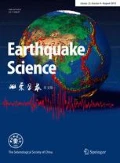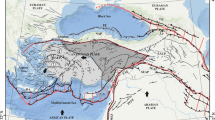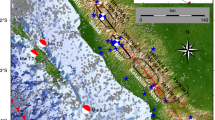Abstract
In this paper a two-dimensional (2-D) model of earthquake fault rupturing was presented. It was estabilished on the basis of 1-D spring-block model. Using this model, we studied the dynamical plane-strain fracture problem, modeled the whole dynamical process of nucleating, expanding and propagating of fracture on a 2-D fault with homogeneous or inhomogeneous rupture strength distribution. Our studies show that under homogeneous prestress condition, the fault will gain enough momentum to tear strong obstacles in their propagating path. The rupturing fronts can also propagate forth around the isolated barriers. It is shown that the stopping conditions for rupturing processes play an important role in modeling whole earthquake process. We also studied the dynamical rupturing problems of the fault on which the rupture strength distribution is inhomogeneous, and modeled the earthquake sequence generated on a 2-D fault with the strength distribution of fractal structure. It possesses some similar features as a seismic sequence in the nature. These features mainly depend on the distribution of rupture strength on the fault plane and the level of initial stress drop. The modeling studies which were established on the basis of experiments and observations provided the physical basis for explaining some statistical rules of seismicity.
Similar content being viewed by others
References
Bak, P., Tang, C., 1989. Earthquakes as a self-organized critical phenomenon.J. Geophys. Res.,94(B11): 15 635–15 637.
Carlson, J. M., Langer, J. S. and Shaw, B. E.et al., 1989. Intrinsic properties of a Burridge-Knopoff model of an earthquake fault.Phys. Rev. A.,44(2): 884–897.
Carlson, J. M., Langer, J. S., 1989. Properties of earthquakes generated by fault dynamics.Phys. Rev. Lett.,62(22): 2 632–2 635.
Carlosn, J. M., 1991. Time intervals between characteristic earthquakes and correlations with smaller events: an analysis based on a mechanical model of a fault.J. Geophys. Res.,96: 4 255–4 267.
Jacob, H., Feder, S. and Feder, J., 1991. Self-organized criticality in a stick-slip process.Phys. Rev. Lett,66: 20.
Knopoff, L., Mouton, J. O. and Burridge, R., 1991. The dynamics of a one-dimensional fault in the presence of friction.Geophys. J. R. astr. Soc.,35: 169–184.
Author information
Authors and Affiliations
Additional information
This subject is supported by the Chinese Joint Seismological Science Foundation.
About this article
Cite this article
Chen, XX. A two-dimensional earthquake fault modeling with fractal structure strength distribution. Acta Seismologica Sinica 9, 593–603 (1996). https://doi.org/10.1007/BF02651049
Received:
Revised:
Accepted:
Issue Date:
DOI: https://doi.org/10.1007/BF02651049




